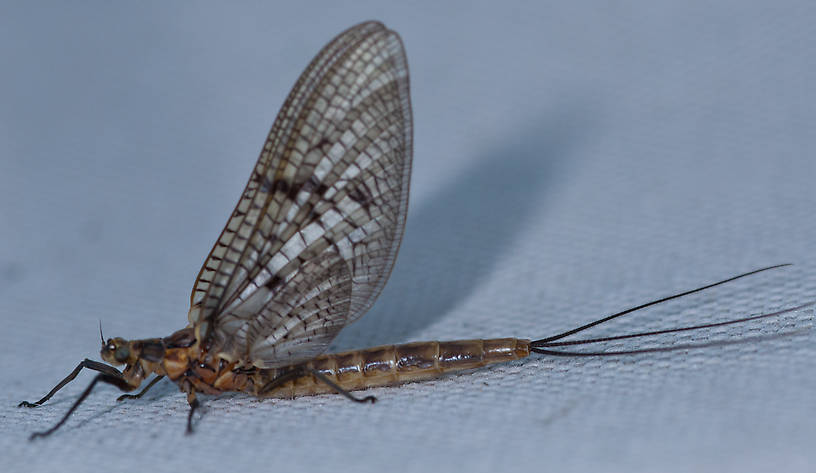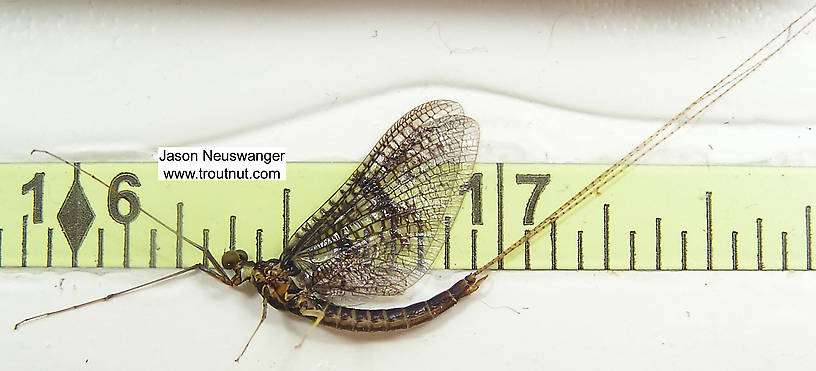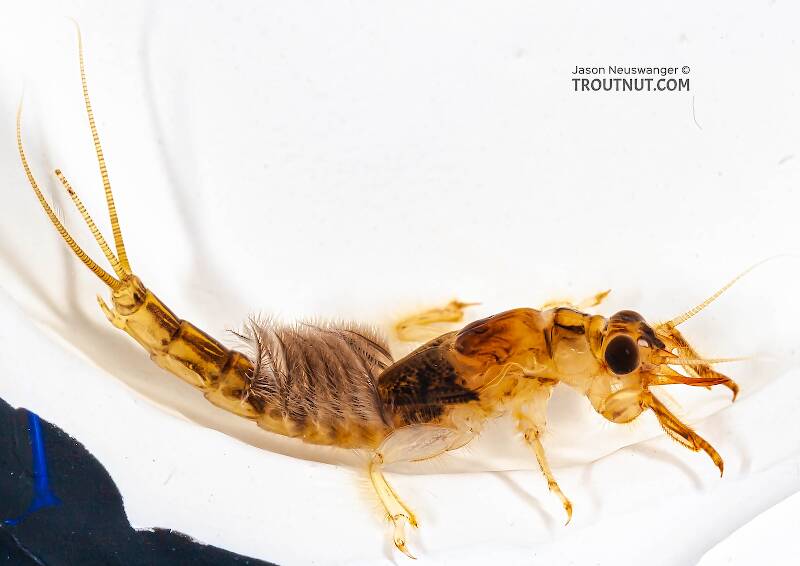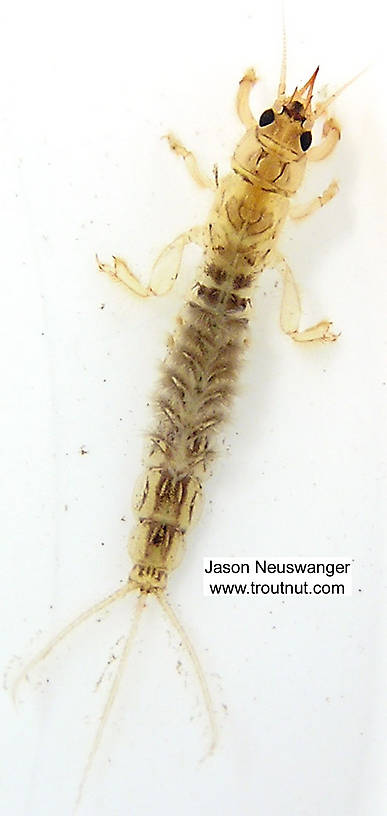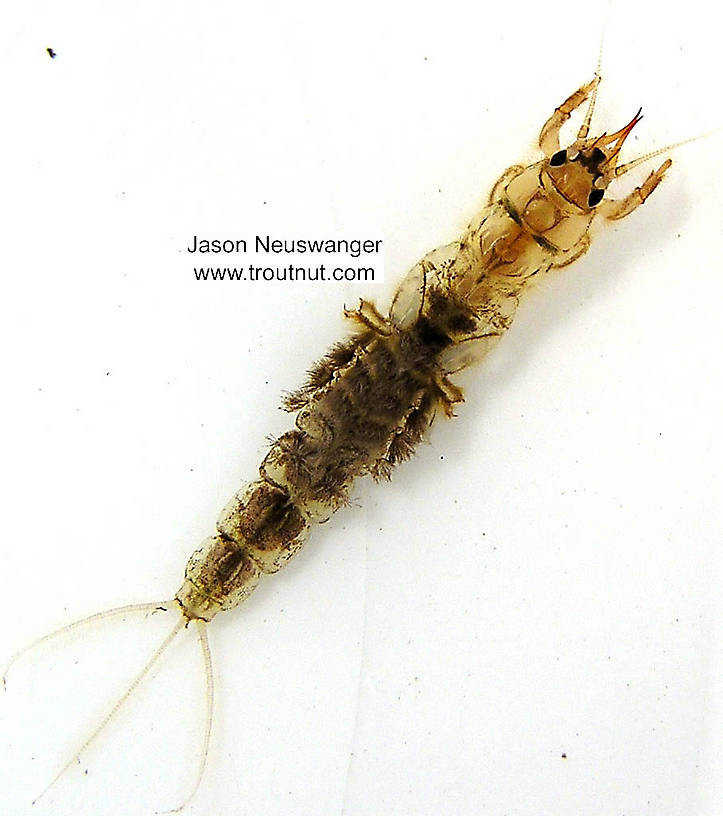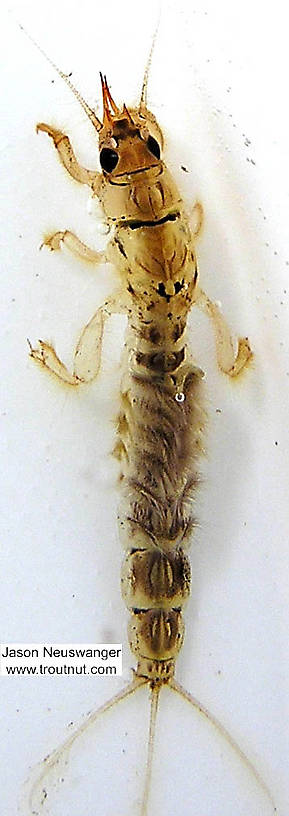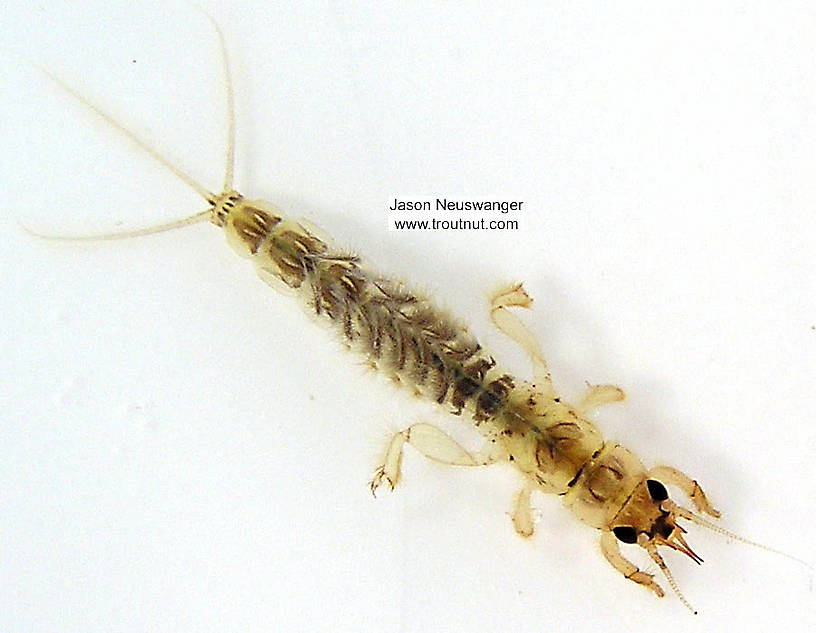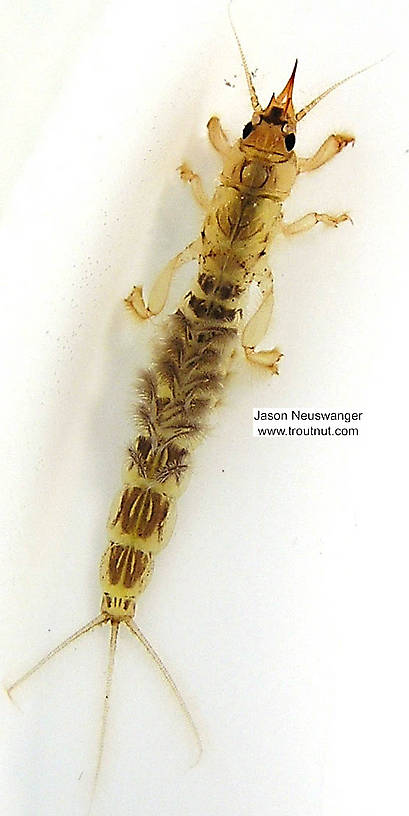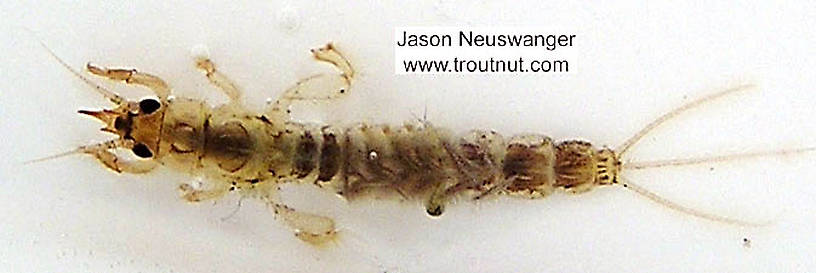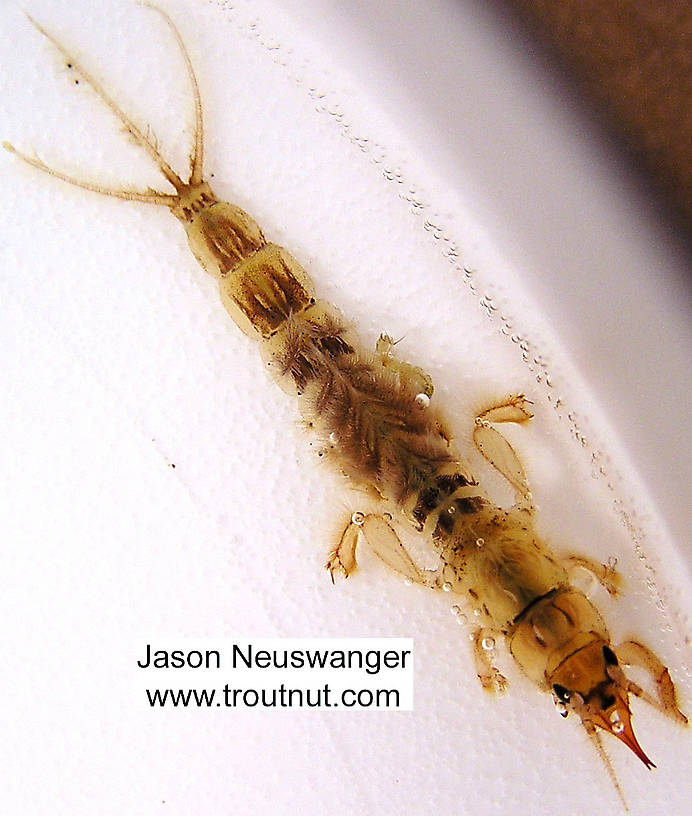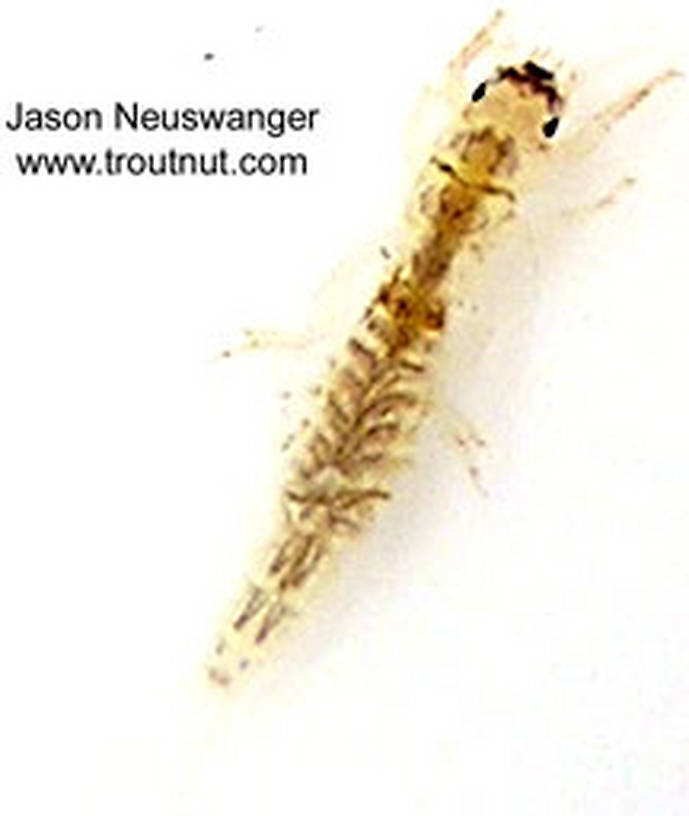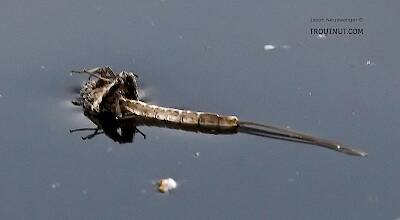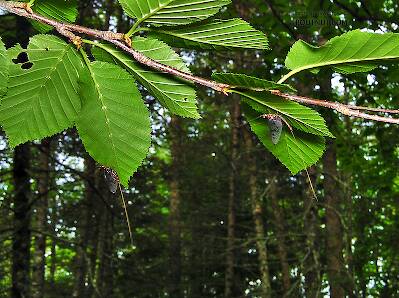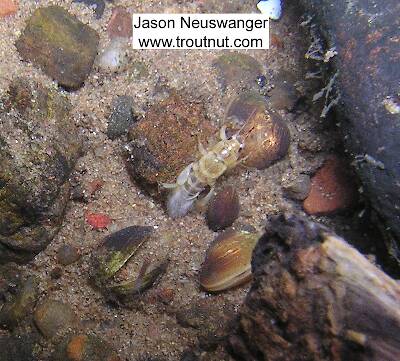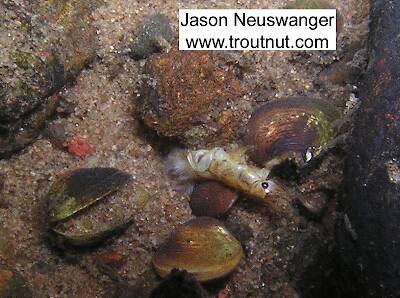
Salmonflies
Pteronarcys californica
The giant Salmonflies of the Western mountains are legendary for their proclivity to elicit consistent dry-fly action and ferocious strikes.


Mayfly Species Ephemera simulans (Brown Drakes)
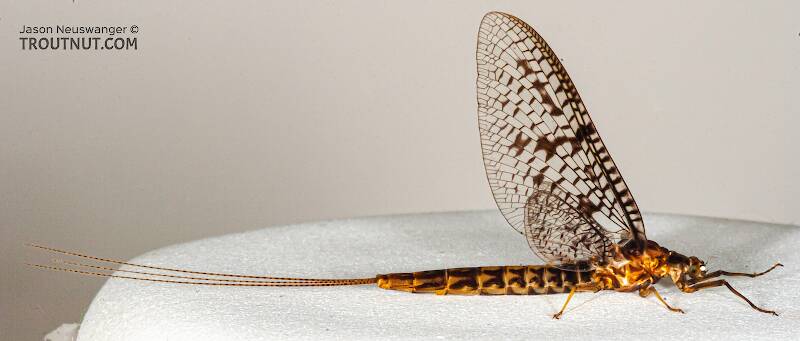
Where & when
It can also create good Eastern hatches in places like the lower Delaware drainage in the Catskills, where its blizzardlike hatches burn out after a few days. Eastern distribution is much spottier than in the Midwest.
This species is also widespread in the West, from Yellowstone to California to Alaska. It emerges later in the year than in the East, extending throughout June and into mid-July. Exceptionally high altitude and latitude can delay it into October.
In 61 records from GBIF, adults of this species have mostly been collected during June (44%), July (28%), May (16%), and August (7%).
In 15 records from GBIF, this species has been collected at elevations ranging from 3 to 5912 ft, with an average (median) of 748 ft.
Species Range
Hatching behavior
This means the best technique for fishing the emergence is to imitate the nymphs. Violent rises may be indicative of trout chasing nymphs to the surface rather than taking duns. There are some accounts of fish feeding on the duns, but they are regarded as the least important stage of this species. Full-hackled imitations are common and successful, imitating the fluttering commotion of duns trying to quickly depart from the water.
Ted Fauceglia says in Mayflies that the best dun emergence occurs in mid to late afternoon. This conflicts with other authors, who write that afternoon emergence is uncommon phenomenon reserved for exceptionally cold, dark days.
Spinner behavior
Time of day: Dusk and into darkness
The spinners appear at treetop height up to an hour or two before dark. Their clouds descend gradually, and on some nights they are so thick that they land all over the angler and anything else in the river. I had one of the large drakes fly straight into my eye--yet another reason to wear sunglasses while fishing.
Some nights the descending clouds of spinners frustratingly disappear back into the trees. Other times they blanket the water and every trout in the stream, including huge piscivorous browns, may rise to them.
Nymph biology
Current speed: Slow to medium
Substrate: Sand and fine gravel, sometimes silt
They prefer sand and fine gravel over the firm silt of their relatives in Hexagenia, but they are present in silty places too. My favorite place to collect them is a silty culvert pool in the headwaters of a small brook trout stream. Ephemera simulans cohabits there with Baetisca laurentina, Siphloplecton basale, and Eurylophella temporalis--a very uncommon bunch.
Ephemera simulans Fly Fishing Tips
Some anglers curse this hatch as an over-hyped disappointment. The promising clouds of spinners which vanish without falling spent certainly contribute to this frustration. It is more likely that anglers are seeing simultaneous emergences and spinner falls. The trout may eat their fill of nymphs below the surface and leave a blanket of spinners untouched, leaving the impression that they do not care for this species.Physical description
Most physical descriptions on Troutnut are direct or slightly edited quotes from the original scientific sources describing or updating the species, although there may be errors in copying them to this website. Such descriptions aren't always definitive, because species often turn out to be more variable than the original describers observed. In some cases, only a single specimen was described! However, they are useful starting points.
Male Spinner
Wing length: 12–14 mm
A dark brown species; both wings with numerous dark blotches and many margined cross veins; tails dark reddish brown.
Head deep blackish brown; antennae pale brown, tips whitish. Thorax deep blackish brown; a large pale patch on prothoracic pleura, mesothoracic pleura marked with smaller pale areas. Median portion of anterior and posterior margins of pronotum narrowly pale, also a narrow pale streak laterad of mesonotal scutellum and pale median area on prosternum. Base of fore leg pale; coxa, trochanter, femur and tibia dark red-brown, joinings blackish; tarsus paler red-brown, each joint darker apically. Middle and hind femora pale reddish brown, tibiae and tarsi yellowish with smoky tinge; all joinings darker.
Fore wing much as in Ephemera varia, but less tinged with brownish apically, many more cross veins heavily margined, several additional brown clouds. Longitudinal veins dark brown, cross veins blackish, those in costal, subcostal and radial spaces widely margined except at apex of last two; many in disc likewise margined, also several near outer margin. Stripe at region of bulla deep brown in color, slightly wider than in varia; in apical third of wing beyond this are two dark brown clouds, at fork of radial sector and at fork in next space below, nearer margin. Cloud toward margin from inner end of bullar stripe larger than in varia, as is also that at base of long intercalary of media; between this and bullar stripe, another small cloud. Veins of hind wing also dark brown, those of basal subcostal space and many in disc dark-margined, the latter forming a number of small dark spots. Outer margin rather widely tinged with light brown (fig. 79).
Abdomen pale brown, with blackish brown markings. On each side of each tergite is a large irregular blotch occupying most of lateral area, and based on anterior margin; lateral and posterior edges of each blotch rather deeply emarginate, so as to leave small pale areas; lateral edges black. Posterior margins of basal and middle tergites narrowly pale brown, also median area, which is narrow on basal and apical tergites, widest on middle ones. On tergites 7-9 a pair of black submedian streaks, very short on 7. Sternites 1-6 with dark lateral triangles, widest posteriorly; 7-9 with dark longitudinal streaks laterally. A pair of small dark spots on each side of median line, on each sternite, also short dark oblique submedian streaks from anterior margin. Middle area of sternite 9 pale. Forceps base and forceps smoky brown; second forceps joint relatively short, as compared with Ephemera varia. Penes broader than in varia; yellowish brown (fig. 82). Tails deep yellow to reddish brown, joinings darker.
This species is darker than any other in our fauna. Distinguished from Ephemera varia as indicated above, also by its much darker body, legs and tails.
Specimens of the Mayfly Species Ephemera simulans
1 Male Dun
2 Male Spinners
12 Nymphs
2 Streamside Pictures of Ephemera simulans Mayflies:
2 Underwater Pictures of Ephemera simulans Mayflies:
2 Videos of Ephemera simulans Mayflies:
This little Ephemera nymph swam around for a while and tried to burrow into the sand in my photography tank.
Discussions of Ephemera simulans
Thanks.
I was talking with the Queen of the Brown Drakes - Chloe Manz the other day and she was insisting that the nymphs only emerge in the late evening. I was countering that I was under the impression that they emerge in the early morning hours and sometimes during the mid day hours.
Any acurate info???
Observation on my part has subimagos around during the daylight and taking refuge in the riprian foliage until a return to the water in the very late evening (under the right conditions) as imagos for a mating flight and egg laying.
I would be interested to know if anyone has had any success fishing the emerging nymphs. I have ties up some nice, big soft hackles and am itching to give em a whirl.
By the way....there is a masking hatch up near my home stream of Sulphurs that takes a trump card over the bigger Brown Drake most evenings...last night I mistakenly switched to a Brown Drake spinner after very successfully fishing a Sulphur dun for an hour.
I could hear the fish change the sucking noises as the evening progressed into darkness and spent a unfruitfull 1/2 hour steadily working a couple of very nice fish with the brown drake spent pattern before turning my attention to the evidence...I put the headlamp on the surface and saw that the Sulphur spinners were much more predominant.
I then switched to a more appropriate spent pattern and got a bit of redemption!
Glorious evening none the less and lesson well learned!
Start a Discussion of Ephemera simulans
References
- Arbona, Fred Jr. 1989. Mayflies, the Angler, and the Trout. Nick Lyons Books.
- Caucci, Al and Nastasi, Bob. 2004. Hatches II. The Lyons Press.
- Fauceglia, Ted. 2005. Mayflies . Stackpole Books.
- Knopp, Malcolm and Robert Cormier. 1997. Mayflies: An Angler's Study of Trout Water Ephemeroptera . The Lyons Press.
- Leonard, Justin W. and Fannie A. Leonard. 1962. Mayflies of Michigan Trout Streams. Cranbrook Institute of Science.
- Needham, James G., Jay R. Traver, and Yin-Chi Hsu. 1935. The Biology of Mayflies. Comstock Publishing Company, Inc.
- Swisher, Doug and Carl Richards. 2000. Selective Trout. The Lyons Press.
Mayfly Species Ephemera simulans (Brown Drakes)
Species Range
Resources
- NatureServe
- Integrated Taxonomic Information System
- Global Biodiversity Information Facility
- Described by Walker (1853)


